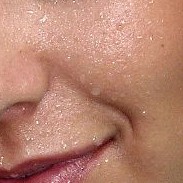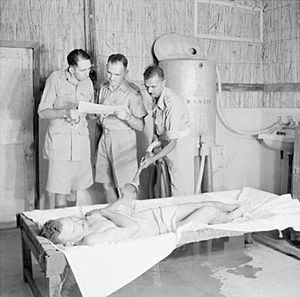Hyperthermia facts for kids
Hyperthermia is when your body gets too hot. It happens when your body can't cool itself down properly. This can be caused by very hot weather, exercising a lot, or even some medicines.
Doctors say you have hyperthermia if your body temperature goes above 101 degrees Fahrenheit. The normal body temperature for most people is around 98.6 degrees Fahrenheit. When your body gets too hot, it can lead to "heat-related injuries." These injuries happen when the high temperature starts to harm your body.
There are three main types of heat-related injuries: heat cramps (the least serious), heat exhaustion, and heat stroke (the most serious and dangerous).
Contents
What Causes Hyperthermia?
Many things can make your body temperature rise too much. Here are some common causes:
- Hot Weather: Being in very hot, sunny, or humid weather can make your body overheat.
- Lots of Activity: Exercising or working hard, especially when it's hot outside, can cause hyperthermia.
- Age: Very old people and babies can get hyperthermia even if they are resting indoors. This happens if the weather is hot and humid, and they don't get enough cool air. Their bodies have a harder time controlling temperature.
- Certain Substances: Some substances can make your body's temperature get very hot, very quickly.
Other things can make you more likely to get hyperthermia, especially if you are active:
- Clothing: Wearing dark clothes, hats, helmets, or padded gear (like sports pads) can trap heat.
- Body Weight: Having more body fat can make it harder for your body to cool down.
- Dehydration: Not drinking enough fluids makes it harder for your body to cool itself by sweating.
- Fever: If you already have a fever, your body temperature is higher than normal, making it easier to overheat.
- Medicines: Some medicines can affect your body's ability to cool down.
Heat Cramps
Heat cramps are the mildest form of hyperthermia. A "cramp" is a sudden, sharp pain when a muscle tightens up.
Symptoms of Heat Cramps
The main signs of heat cramps are:
- Painful muscle cramps, usually in your legs or stomach area.
- Sweating a lot, which can lead to not having enough fluids (dehydration) and losing important salts your body needs.
Treating Heat Cramps
Most people with heat cramps don't need to see a doctor. The best ways to treat them are:
- Move to a cool place and rest.
- Rest the muscles that are hurting.
- Drink water or sports drinks to get more fluids.
Heat Exhaustion
Heat exhaustion is more serious than heat cramps. It affects your whole body, not just certain muscles.
Symptoms of Heat Exhaustion
Signs of heat exhaustion can include:
- Feeling dizzy or fainting.
- Low blood pressure.
- More serious dehydration. You might feel dizzy when you stand up, which is a sign of dehydration.
- Feeling very thirsty with a dry mouth.
- Cool, clammy skin (this means your body is trying very hard to sweat and cool down).
- Feeling sick to your stomach or throwing up because of dehydration.
Treating Heat Exhaustion
People with heat exhaustion might need medical help.
If someone has heat exhaustion, here's what to do first:
- Move them to a cool place.
- Help them take off any extra layers of clothes.
- Cool them down by fanning them and putting wet towels on their body.
- Have them lie down and put their feet up if they feel dizzy.
- Give them water or sports drinks, but only if they are awake, not confused, and not throwing up.
- If they are throwing up, turn them onto their side.
If someone with heat exhaustion gets medical treatment, paramedics or doctors might:
- Give them oxygen.
- Give them water and important salts through a needle in their vein if they are too confused to drink or are throwing up.
Heat Stroke
Heat stroke is a medical emergency. If it's not treated very quickly, it can cause brain damage and even death. It's one of the most common causes of death in sports that could have been prevented.
Heat stroke happens when a person gets so hot that their body can no longer cool itself down at all. The body has tried everything it can, but nothing works anymore. This causes the body temperature to rise very fast. The inside of the body gets so hot that its tissues, especially the brain, get damaged. Usually, people with heat stroke have a body temperature of 104 degrees Fahrenheit or higher. The brain cannot survive for long at these temperatures. Heat stroke can quickly damage the brain, heart, kidneys, and muscles.
Symptoms of Heat Stroke
Early Signs
Often, the first signs of heat stroke are:
- Agitation (the person gets upset and restless).
- Confusion.
- A strong, fast heartbeat.
Later Signs
As heat stroke gets worse, more dangerous signs appear. For example:
- Seizures (uncontrolled shaking), especially if they don't stop.
- Very low blood pressure (too low for blood and oxygen to reach the brain).
- A weak, slow heartbeat (this means the heart can't pump blood strongly enough).
- Delirium (severe confusion) or coma (being unconscious). These are caused by the brain getting too hot and not getting enough oxygen.
- The person's skin will also be red, hot, and dry. This is because the body can no longer sweat to cool itself.
Treating Heat Stroke
People with heat stroke always need emergency medical treatment right away. If you think someone might have heat stroke, you should call 9-1-1 or your local emergency number immediately. The person on the phone can tell you what to do to help until an ambulance arrives.
Once the person with heat stroke gets to an ambulance or a hospital, treatments may include:
- Cooling the person down as fast as possible. Ways to do this include:
- Taking off their clothes.
- Covering them with wet towels.
- Turning up the air conditioning or using a fan.
- Putting ice packs in their armpits, on the back of their neck, and in their groin area.
- Putting the person into an ice bath.
- Giving cold fluids through a needle in their vein to help cool them down and treat dehydration.
- Giving medicines to stop shivering, because shivering makes the body even warmer.
- Giving medicines to stop seizures.
- Giving medicines to help heart problems caused by the heat stroke.
- Giving oxygen, or putting a tube down the person's throat to help them breathe.
What Happens After Heat Stroke?
How well someone recovers from heat stroke depends on how high their body temperature got, how quickly it rose, and how fast they received treatment.
Up to 80% of people who don't get treatment for heat stroke right away can die. But if people with heat stroke are cooled down and treated very quickly, this number can drop to only 10%. However, some people who survive heat stroke may have brain damage or other health problems because of it.
See also
 In Spanish: Hipertermia para niños
In Spanish: Hipertermia para niños



